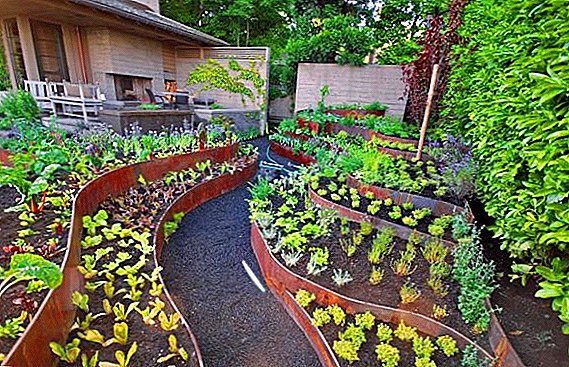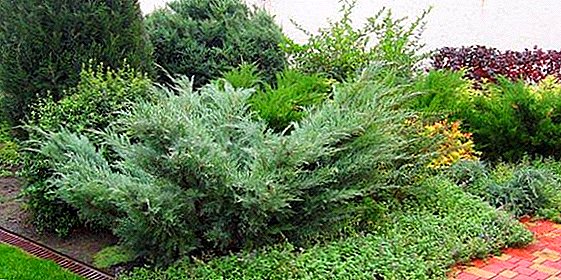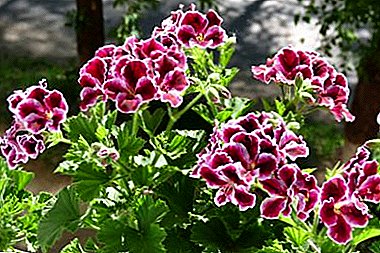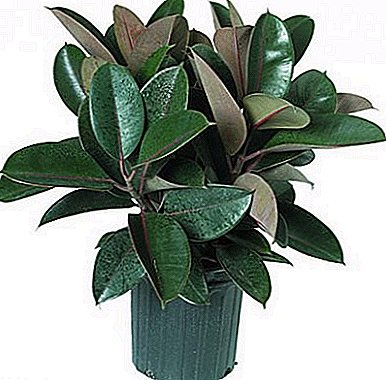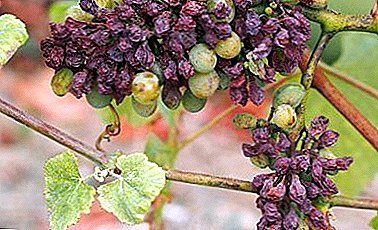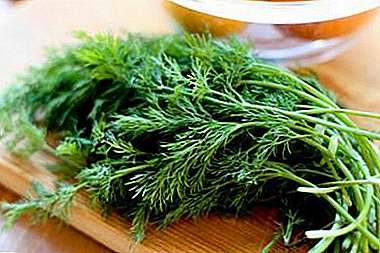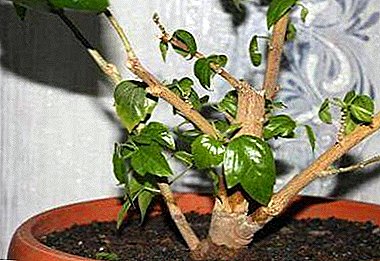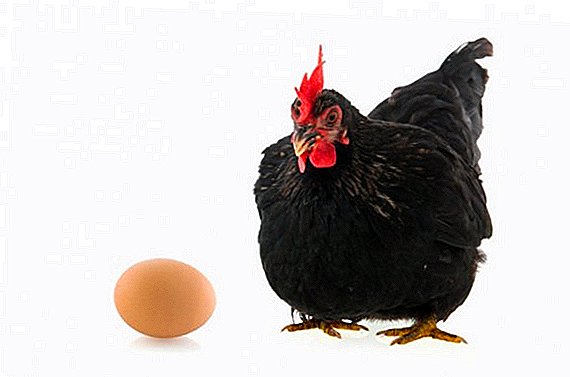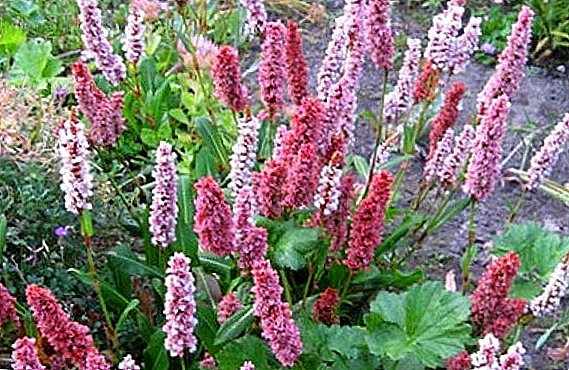 Hardy perennial (scientifically-tsimitsifuga) remains popular. This herb is well received at the dacha plots, where for a long time it pleases the eye with massive vertical "brushes" of inflorescences. In the review, we will look at how the main species are remarkable and which varieties are most in demand.
Hardy perennial (scientifically-tsimitsifuga) remains popular. This herb is well received at the dacha plots, where for a long time it pleases the eye with massive vertical "brushes" of inflorescences. In the review, we will look at how the main species are remarkable and which varieties are most in demand.
American
The height varies from 0.9 to 1.5 m. The leaves are dark green in color. From July to the end of summer flowering occurs: beige flowers appear with a gray tint.  They are assembled in brushes of the correct cylindrical form. The grade fructifies, as a fruit nuts act.
They are assembled in brushes of the correct cylindrical form. The grade fructifies, as a fruit nuts act.
Brunette
Black cohosh is distinguished by its unusual appearance. The stem itself is purple, with brown "strokes" (leaves have the same color). With proper care, the height can reach 1.7-1.8 m.  In the middle of summer on the inflorescences (about 20 cm), luxurious white-purple flowers are seen, exuding a pleasant aroma.
In the middle of summer on the inflorescences (about 20 cm), luxurious white-purple flowers are seen, exuding a pleasant aroma.
Important! The planting technology is simple: a “organic” (at least shredded manure) is laid in a well 30 cm deep, after which the tsimitsifugu itself is carefully placed there. Between plants try to maintain an interval of at least 60 cm.This view is great for group compositions in the flower garden and is accepted even in thick shadow.
Black negligee
It is considered the best among all varieties that have a dark color. A rather tall (1.5 m) stem with delicate leaves of rich cherry color will become the “nail” of the back yard.  Klopogon black negligee lets color in August and September, the flowers can be both scarlet and transparent bluish (depending on the choice of planting material).
Klopogon black negligee lets color in August and September, the flowers can be both scarlet and transparent bluish (depending on the choice of planting material).
Branched
The representative of the high lines. Branching stem with maroon-purple leaves can calmly grow up to 2 m, and a well-developed rhizome with many branches gives it a special endurance. It belongs to the family to the family Buttercups, as well as all types of black cohosh.  The flowering period falls in autumn (September-October), when small flowers of snow-white color can be seen.
The flowering period falls in autumn (September-October), when small flowers of snow-white color can be seen.
The inflorescence of this variety is slightly different from the usual for the whole kind of "cylinders" and strict panicles - for example, the tsimitsifuga branchy line of James Compton as it gathers flowers into a spikelet. His smell is light and pleasant.
The buttercup family also includes hellebore, aquilegia, bathing vessel, anemone, and basil.
Smelly
The plant corresponds to its name - the ground part exudes not the most pleasant smell. And when transplanting, it turns out that the root is the same.
Did you know? The plant is also known as Voronets (now this name is even more common). The Germans, noting the beauty of the flowers, call the black cohosh, which we are used to, “silver candle”.On a high stem (up to 2 m) are large feathery leaves. The bottom sheets are distinguished by a ribbed shape (for which the flower has received the name "Adam's rib" among the people).
 In July-August, small green and white flowers open on small (up to 14 cm) paniculate inflorescences.
In July-August, small green and white flowers open on small (up to 14 cm) paniculate inflorescences.This species is widely used in traditional medicine. From the "stinker" make decoctions and tinctures, which are used in the treatment of rheumatism, colds, dental and headaches.
As well as black cohosh in folk medicine, a summer crocus is used, as well as kupena, actinidia, povilka, derbennik, chervil, a bathing vessel, fir.Some doctors say that it is suitable as an antidote for snake bites.
Daursky
Klopogon Dahurian varieties have a small (1-1.5 m) stem. The leaves are slightly pointed, with teeth on the edges. The flowers are beige in color, apparently even inconspicuous, gathered in a "whisk".
Flowering begins in the second decade of July and may continue until early September. 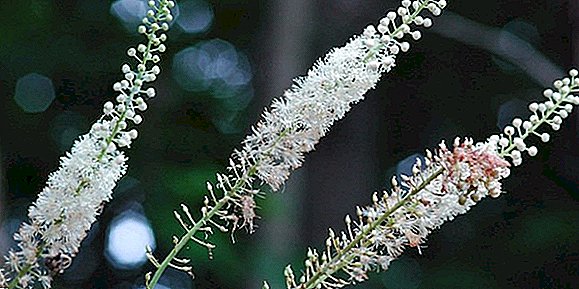 In August, fruiting dry nuts 2-3 mm. In each such nutlet there are several leaflets in which 7-8 seeds are laid.
In August, fruiting dry nuts 2-3 mm. In each such nutlet there are several leaflets in which 7-8 seeds are laid.
Pisiform
A large plant with a 2-meter stem and a 60 cm bush circumference. There are also 2.5 m tall specimens.
Important! Fans of transplants better leave such a plant alone - the flower shift places pretty hard. At one site, the insecticide can safely grow 10-15, and sometimes all 20 years.
Similar to inflorescences - large and fragrant during flowering, reaching up to 80 cm. Leaves are saturated green with a dull shade.  In July, flowering begins: on the lower half of the brush are visible white or cream flowers, which gradually unfold from the base of the peduncle and to its top.
In July, flowering begins: on the lower half of the brush are visible white or cream flowers, which gradually unfold from the base of the peduncle and to its top.
Cordifolia
Another impressive size. On suburban areas it grows to at least 1.2 m, and on well-groomed soil it easily reaches the mark of 2 m. The leaves are green, slightly faded.  The inflorescences in the form of a regular “broom” in the second half of summer are covered with small white flowers, around which there is a pronounced honey aroma.
The inflorescences in the form of a regular “broom” in the second half of summer are covered with small white flowers, around which there is a pronounced honey aroma.
Plain
A small plant rarely grows above 1 m. But by its distribution it will give odds to many “thoroughbred” varieties. Typical representative species - Black cohosh simple line White Pearl.
Did you know? Black cohope itself - forest plant. Its habitat is considered to be the American and Asian arrays. There are many such "plantations" in the forests of Altai and Western Siberia.
It can be distinguished by the light green tone of the leaves, which come with double dissection. On the tops of a few peduncles, magnificent "tassels" of inflorescences are located.  The flowering time is the last weeks of the summer and the first two decades of September, when white flowers with lowered heads are revealed.
The flowering time is the last weeks of the summer and the first two decades of September, when white flowers with lowered heads are revealed.
Japanese
The standard height of this species is 1.5-2 m. The medium leaves of regular shape have a dark green color (on a sunny day they do not give a reflection, the reflection is dull).  On the tops of erect peduncles brush inflorescences are seen. "Japanese" favorably with European varieties that blooms almost all summer.
On the tops of erect peduncles brush inflorescences are seen. "Japanese" favorably with European varieties that blooms almost all summer.
Small beige flowers with a beige shade look great against the backdrop of lush greenery. In rare cases, the color changes to silvery white.
All of these varieties are well accepted on our soils, and their resistance to diseases and pests is enviable. 
Important! If tsimitsifuga is grown for medicinal purposes, then it is not sprayed with potent fertilizers or chemicals. Hitting drops from other plants (for example, in a gust of wind) is also undesirable.
The beauty / benefit ratio is another argument in favor of black cohosh. As you have seen, behind such an unattractive name lies a spectacular and "sensible" plant, with the landing of which anyone can handle. More bright colors in the country and in life!


